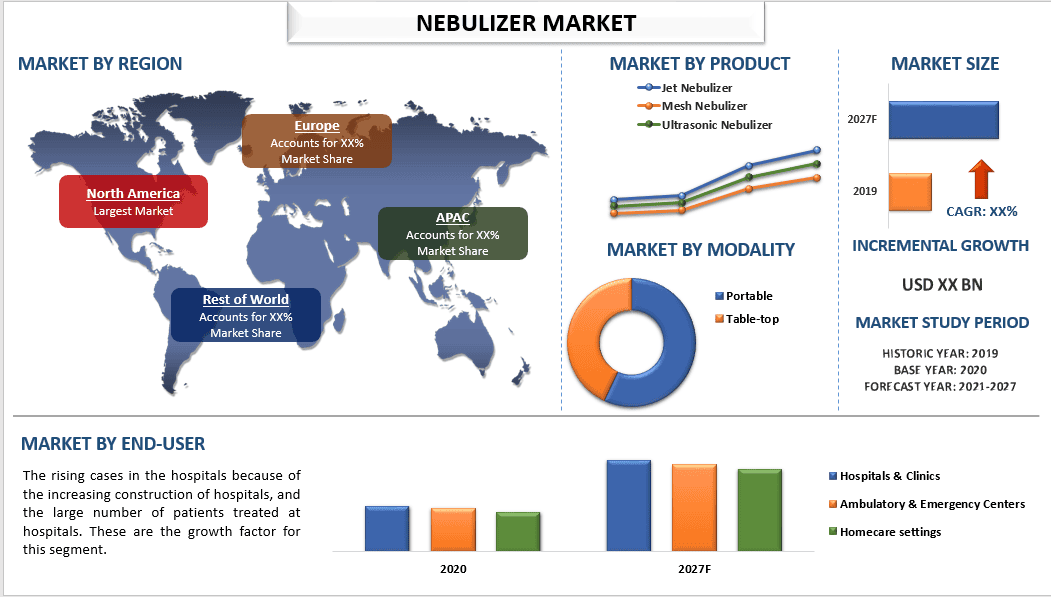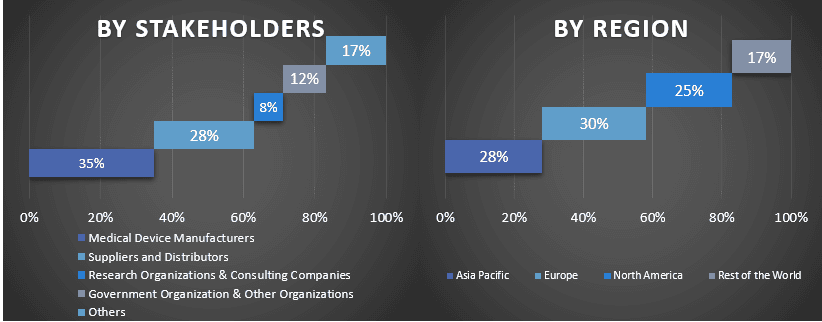- Home
- About Us
- Industry
- Services
- Reading
- Contact Us
Nebulizer Market: Current Analysis and Forecast (2021-2027)
Emphasis By Product (Jet Nebulizer, Mesh Nebulizer, Ultrasonic Nebulizer); By Modality (Portable, Table-top); By End-User (Hospitals & Clinics, Ambulatory & Emergency Centers, Homecare settings) and Region/Country

The nebulizer market is expected to witness a CAGR of around 7% during the forecast period (2021–2027). A nebulizer is a medical device that converts medicines into mist and delivers it directly into the lungs and the respiratory system through a mask or a mouthpiece. The technique of nebulization is commonly used for the treatment of, lung diseases, pulmonary fibrosis, asthma, and COPD. Moreover, rising pollution and cardiovascular diseases in developing countries are some of the main factors that are expected to drive market growth during the forecast period. For instance, in 2020, according to the World Health Organization (WHO), Asthma affected an estimated 262 million people in 2019 and caused 455,000 deaths.
Briggs Medical Service Company, Besco Medical, Flyp Nebulizers, DeVilbiss Healthcare International, Omron Corporation, Becton, Dickinson and Company, Feellife Health Inc., Pari Medical Ltd., Philips Respironics, Inc., and Graham Field (GF) Health Products, Inc. are some of the key players in the market. Several M&As along with partnerships have been undertaken by these players to facilitate customers with the new and advanced nebulizers.
Insights Presented in the Report
“Amongst Product, the jet nebulizers category accounted for the majority share in the market in 2020”
Based on product, the nebulizer market is segmented into jet nebulizers, mesh nebulizers, and ultrasonic nebulizers. In 2020, the jet nebulizers category is anticipated to witness a significant growth rate during the forecast period owing to the rising prevalence of chronic obstructive pulmonary disease (COPD), asthma, pulmonary fibrosis, and tuberculosis. In addition, the most prescribed form of treatment for COPD diseases is inhalation therapy, including inhalers and nebulizers. The fast and effective relief of symptoms from a nebulizer can greatly improve a patient’s health. According to the World health organization (WHO), Chronic obstructive pulmonary disease (COPD) is the third leading cause of death worldwide, causing 3.23 million deaths in 2019.
“Amongst Modality, the portable category is expected to witness significant growth rate during the forecast period”
Based on modality, the nebulizer market is segmented into portable and tabletop. In 2020, the portable category is anticipated to witness a significant growth rate during the forecast period. Portable nebulizers are lightweight, more compact in size, convenient to carry around, and battery-operated. Moreover, the growth of this segment is mainly due to the increased number of pulmonary fibrosis, lung infections, CVDs, and respiratory diseases. For instance, according to the World Health Organization (WHO), Out of the 17 million premature deaths due to noncommunicable diseases in 2019, 38% were caused by CVDs.
“Amongst End-User, the hospitals and clinics category held a significant share in the market in 2020”
Based on end-user, the nebulizer market is categorized into hospitals & clinics, ambulatory & emergency centers, and home care settings. In 2020, the hospitals & clinics category held a significant market share in the market and is expected to grow significantly in the upcoming years. This category especially driven by the higher number of patients with co-morbid conditions has been pivotal in higher demand for table-top and portable devices from these settings globally. In addition, rising cases of respiratory diseases, lung infections, and the availability of skilled professionals in hospitals are some reasons for the growth of this segment.
“North America to witness significant growth during the forecast period”
For a better understanding of the market, the report provides a detailed analysis of major regions and countries including North America (U.S., Canada, Rest of North America); Europe (Germany, U.K., France, Spain, Italy, Rest of Europe); Asia-Pacific (China, India, Japan, Australia, South Korea, Rest of Asia-Pacific) and Rest of World. In 2020, North America accounted for a significant market share. This is mainly due to the well-established healthcare infrastructure coupled with high income and developed healthcare reimbursement policies in countries of the region. Furthermore, growing cases of lung infection diseases and chronic respiratory diseases are some key factors that will drive the market growth rate in this region. For instance, according to the Centers for Disease Control and Prevention (CDC), In the U.S., 1.5 million people were diagnosed with pneumonia in an emergency department in 2018. Unfortunately, more than 40,000 people died from the disease that year in the U.S.
Reasons to buy this report:
- The study includes market sizing and forecasting analysis validated by authenticated key industry experts.
- The report presents a quick review of overall industry performance at one glance.
- The report covers an in-depth analysis of prominent industry peers with a primary focus on key business financials, product portfolio, expansion strategies, and recent developments.
- Detailed examination of drivers, restraints, key trends, and opportunities prevailing in the industry.
- The study comprehensively covers the market across different segments.
- Deep dive regional level analysis of the industry.
Customization Options:
The nebulizer market can further be customized as per the requirement or any other market segment. Besides this, UMI understands that you may have your own business needs, hence feel free to connect with us to get a report that completely suits your requirements.
Table of Content
Research Methodology for the Nebulizer Market Analysis (2021-2027)
Analyzing the historical market, estimating the current market, and forecasting the future market of the nebulizer market were the three major steps undertaken to create and analyze the adoption of the nebulizer market in major regions globally. Exhaustive secondary research was conducted to collect the historical market numbers and estimate the current market size. Secondly, to validate these insights, numerous findings and assumptions were taken into consideration. Moreover, exhaustive primary interviews were also conducted, with industry experts across the value chain of the nebulizer market. Post assumption and validation of market numbers through primary interviews, we employed a top-down/bottom-up approach to forecasting the complete market size. Thereafter, market breakdown and data triangulation methods were adopted to estimate and analyze the market size of segments and sub-segments of the industry pertains to. Detailed methodology is explained below:
Seek More Details About Research Methodology
Analysis of Historical Market Size
Step 1: In-Depth Study of Secondary Sources:
Detail secondary study was conducted to obtain the historical market size of the nebulizer market through company internal sources such as annual reports & financial statements, performance presentations, press releases, etc., and external sources including journals, news & articles, government publications, competitor publications, sector reports, third-party database, and other credible publications.
Step 2: Market Segmentation:
After obtaining the historical market size of the nebulizer market, we conducted a detailed secondary analysis to gather historical market insights and share for different segments & sub-segments for major regions. Major segments are included in the report as product, modality, and end-user. Further country-level analyses were conducted to evaluate the overall adoption of testing models in that region.
Step 3: Factor Analysis:
After acquiring the historical market size of different segments and sub-segments, we conducted a detailed factor analysis to estimate the current market size of the nebulizer market. Further, we conducted factor analysis using dependent and independent variables such as various product, modality, and end-user of the nebulizer market. A thorough analysis was conducted for demand and supply-side scenarios considering top partnerships, mergers and acquisitions, business expansion, and product launches in the nebulizer market sector across the globe.
Current Market Size Estimate & Forecast
Current Market Sizing: Based on actionable insights from the above 3 steps, we arrived at the current market size, key players in the nebulizer market, and market shares of the segments. All the required percentage shares split, and market breakdowns were determined using the above-mentioned secondary approach and were verified through primary interviews.
Estimation & Forecasting: For market estimation and forecast, weights were assigned to different factors including drivers & trends, restraints, and opportunities available for the stakeholders. After analyzing these factors, relevant forecasting techniques i.e., the top-down/bottom-up approach were applied to arrive at the market forecast about 2027 for different segments and sub-segments across the major markets globally. The research methodology adopted to estimate the market size encompasses:
- The industry’s market size, in terms of revenue (USD) and the adoption rate of the nebulizer market across the major markets domestically
- All percentage shares, splits, and breakdowns of market segments and sub-segments
- Key players in the nebulizer market in terms of solutions offered. Also, the growth strategies adopted by these players to compete in the fast-growing market
Market Size and Share Validation
Primary Research: In-depth interviews were conducted with the Key Opinion Leaders (KOLs) including Top Level Executives (CXO/VPs, Sales Head, Marketing Head, Operational Head, Regional Head, Country Head, etc.) across major regions. Primary research findings were then summarized, and statistical analysis was performed to prove the stated hypothesis. Inputs from primary research were consolidated with secondary findings, hence turning information into actionable insights.
Split of Primary Participants in Different Regions

Market Engineering
The data triangulation technique was employed to complete the overall market estimation and to arrive at precise statistical numbers for each segment and sub-segment of the nebulizer market. Data was split into several segments & sub-segments post studying various parameters and trends in the areas of product, modality, and end-user in the nebulizer market.
The main objective of the Nebulizer Market Study
The current & future market trends of the nebulizer market were pinpointed in the study. Investors can gain strategic insights to base their discretion for investments on the qualitative and quantitative analysis performed in the study. Current and future market trends determined the overall attractiveness of the market at a regional level, providing a platform for the industrial participant to exploit the untapped market to benefit from a first-mover advantage. Other quantitative goals of the studies include:
- Analyze the current and forecast market size of the nebulizer market in terms of value (USD). Also, analyze the current and forecast market size of different segments and sub-segments
- Segments in the study include areas of product, modality, and end-user channel.
- Define and analysis of the regulatory framework for the nebulizer market industry.
- Analyze the value chain involved with the presence of various intermediaries, along with analyzing customer and competitor behaviors of the industry.
- Analyze the current and forecast market size of the nebulizer market for the major region.
- Major countries of regions studied in the report include Asia Pacific, Europe, North America, and the Rest of the world.
- Company profiles of the nebulizer market and the growth strategies adopted by the market players to sustain in the fast-growing market
- Deep dive regional level analysis of the industry
Related Reports
Customers who bought this item also bought










